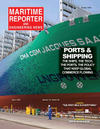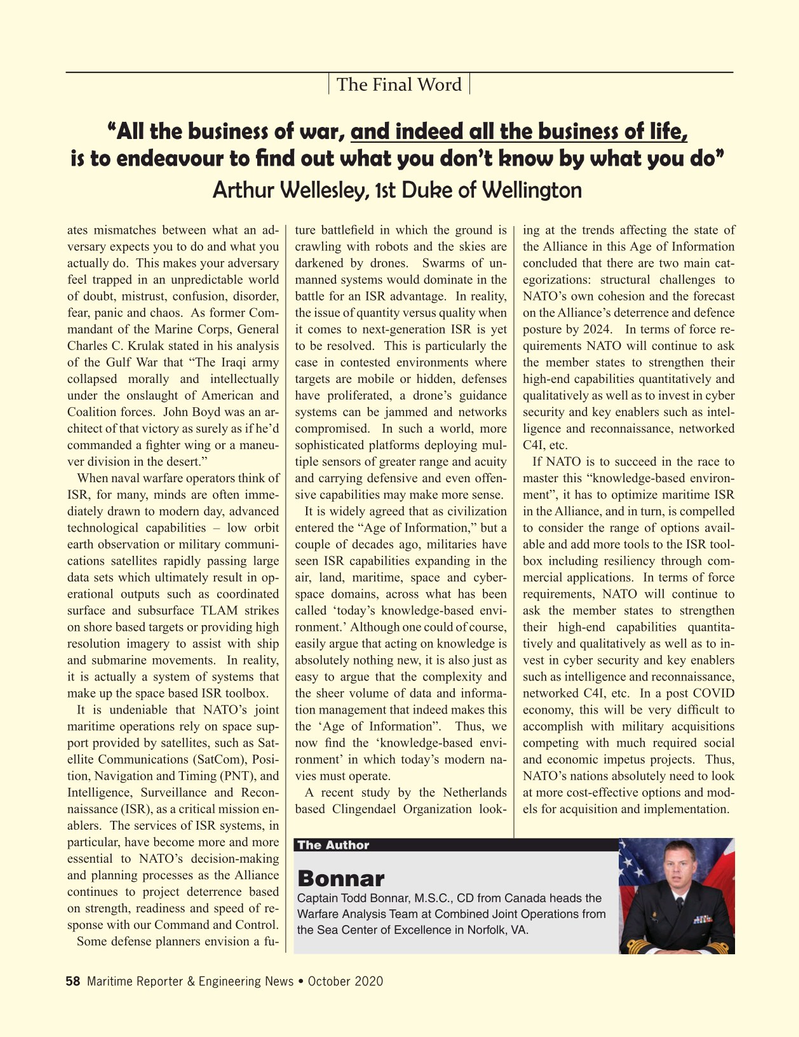
Page 58: of Maritime Reporter Magazine (October 2020)
Shipping & Port Annual
Read this page in Pdf, Flash or Html5 edition of October 2020 Maritime Reporter Magazine
The Final Word “All the business of war, and indeed all the business of life, is to endeavour to ? nd out what you don’t know by what you do”
Arthur Wellesley, 1st Duke of Wellington ates mismatches between what an ad- ture battle? eld in which the ground is ing at the trends affecting the state of versary expects you to do and what you crawling with robots and the skies are the Alliance in this Age of Information actually do. This makes your adversary darkened by drones. Swarms of un- concluded that there are two main cat- feel trapped in an unpredictable world manned systems would dominate in the egorizations: structural challenges to of doubt, mistrust, confusion, disorder, battle for an ISR advantage. In reality, NATO’s own cohesion and the forecast fear, panic and chaos. As former Com- the issue of quantity versus quality when on the Alliance’s deterrence and defence mandant of the Marine Corps, General it comes to next-generation ISR is yet posture by 2024. In terms of force re-
Charles C. Krulak stated in his analysis to be resolved. This is particularly the quirements NATO will continue to ask of the Gulf War that “The Iraqi army case in contested environments where the member states to strengthen their collapsed morally and intellectually targets are mobile or hidden, defenses high-end capabilities quantitatively and under the onslaught of American and have proliferated, a drone’s guidance qualitatively as well as to invest in cyber
Coalition forces. John Boyd was an ar- systems can be jammed and networks security and key enablers such as intel- chitect of that victory as surely as if he’d compromised. In such a world, more ligence and reconnaissance, networked commanded a ? ghter wing or a maneu- sophisticated platforms deploying mul- C4I, etc.
ver division in the desert.” tiple sensors of greater range and acuity If NATO is to succeed in the race to
When naval warfare operators think of and carrying defensive and even offen- master this “knowledge-based environ-
ISR, for many, minds are often imme- sive capabilities may make more sense. ment”, it has to optimize maritime ISR diately drawn to modern day, advanced It is widely agreed that as civilization in the Alliance, and in turn, is compelled technological capabilities – low orbit entered the “Age of Information,” but a to consider the range of options avail- earth observation or military communi- couple of decades ago, militaries have able and add more tools to the ISR tool- cations satellites rapidly passing large seen ISR capabilities expanding in the box including resiliency through com- data sets which ultimately result in op- air, land, maritime, space and cyber- mercial applications. In terms of force erational outputs such as coordinated space domains, across what has been requirements, NATO will continue to surface and subsurface TLAM strikes called ‘today’s knowledge-based envi- ask the member states to strengthen on shore based targets or providing high ronment.’ Although one could of course, their high-end capabilities quantita- resolution imagery to assist with ship easily argue that acting on knowledge is tively and qualitatively as well as to in- and submarine movements. In reality, absolutely nothing new, it is also just as vest in cyber security and key enablers it is actually a system of systems that easy to argue that the complexity and such as intelligence and reconnaissance, make up the space based ISR toolbox. the sheer volume of data and informa- networked C4I, etc. In a post COVID
It is undeniable that NATO’s joint tion management that indeed makes this economy, this will be very dif? cult to maritime operations rely on space sup- the ‘Age of Information”. Thus, we accomplish with military acquisitions port provided by satellites, such as Sat- now ? nd the ‘knowledge-based envi- competing with much required social ellite Communications (SatCom), Posi- ronment’ in which today’s modern na- and economic impetus projects. Thus, tion, Navigation and Timing (PNT), and vies must operate. NATO’s nations absolutely need to look
Intelligence, Surveillance and Recon- A recent study by the Netherlands at more cost-effective options and mod- naissance (ISR), as a critical mission en- based Clingendael Organization look- els for acquisition and implementation.
ablers. The services of ISR systems, in particular, have become more and more
The Author essential to NATO’s decision-making and planning processes as the Alliance
Bonnar continues to project deterrence based
Captain Todd Bonnar, M.S.C., CD from Canada heads the on strength, readiness and speed of re-
Warfare Analysis Team at Combined Joint Operations from sponse with our Command and Control. the Sea Center of Excellence in Norfolk, VA.
Some defense planners envision a fu- 58 Maritime Reporter & Engineering News • October 2020
MR #10 (50-58).indd 58 10/6/2020 9:06:26 AM

 57
57

 59
59
